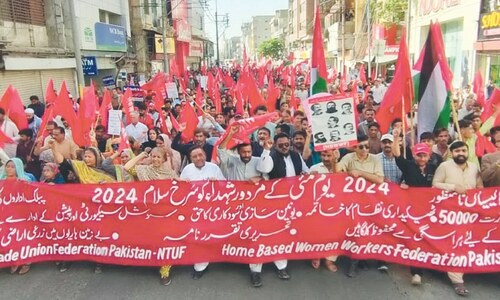
**KARACHI: Nostalgia in recent times has been defined in quite a few ways. For example, while it can be about an ‘unappeased yearning to return’, it can also be about learning lessons. An exhibition titled The ‘70s: Pakistan’s Radioactive Decade curated by Niilofur Farrukh and Amin Gulgee at the latter’s gallery began on Wednesday evening.
It is a stark reminder of how important that decade in the country’s sociopolitical and cultural growth was. Growth, by the way, does not necessarily mean improvement. The radioactive part in the title of the show, as the curators have put it, refers both to nuclear ambitions and memories that like radioactive objects stay in the nation’s psyche.**
The exhibition has works of 40 artists. Most of them celebrate the cultural vibrancy of that era, and some try to look back at things with a fair degree of pensiveness.
Meher Afroz’s ‘Memories from the ‘70s’ (mixed media) points at, among other similar aspects, a debacle that haunts our collective conscience to date: Pakistan and Bangladesh as two separate geographical entities. Which decade did that happen in?
Of course, the cute little objects (a radio transistor, a black telephone we have seen in many films as an integral prop, those red post boxes) that many of us are fond of are there as part of installation exhibits, lending a retro vibe to the whole show. But it’s heartening to hear the voice of the legendary Mehdi Hasan talking about his art in Hamid Rahim’s ‘Khabarnama’ (sound piece). It is tiny moments like these that elevate a project to a level which is essential for cultural reminders.

And who can forget Maula Jatt, the archetypal hero of the ‘70s whose shadow loomed large for more than a decade over the Pakistani film industry. Tapu Javeri pays him a tribute by virtue of a multimedia artwork.
Beenish Mahmood takes the theme a step ahead through her video presentation in a piece interestingly called ‘Touch me not Bashirya’. The compilation of black and white snippets (newspaper cuttings, pop songs, film shots, posters etc) enables the viewer to go down memory lane and at the same time allows that lane to appear in a contemporary setting without looking passé.

Equally noteworthy is Samra Roohi’s appreciation of the period in focus in ‘The conservative liberals’ (lenticular print). No, there is no optical illusion involved here. What may prove to be a tad illusory, in terms of meaningfulness, is the slogan ‘Roti, Kapra, Makan’ on the gallery façade.

The exhibition will remain open until March 20.
Published in Dawn, March 17th, 2016














































Dear visitor, the comments section is undergoing an overhaul and will return soon.